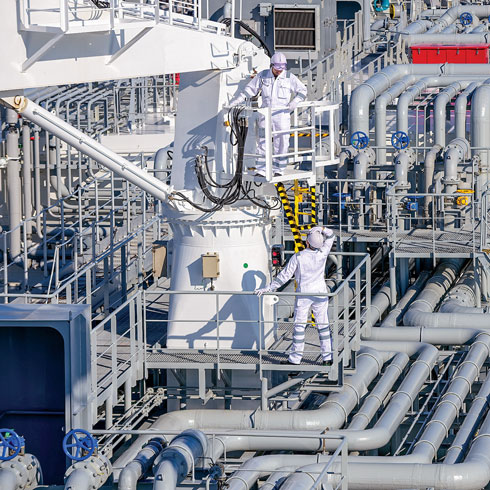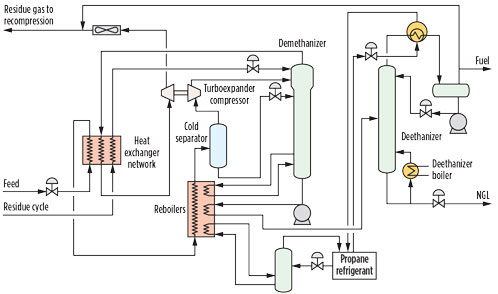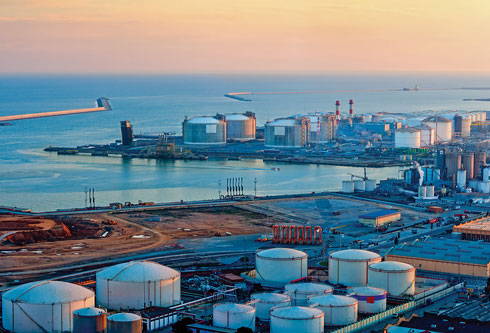Rein in LNG energy costs with advanced process control
M. Tay, Rockwell Automation, Austin, Texas
High energy costs do not need to be a part of daily life in LNG processing and distribution operations. Today, LNG operators often do not have insights into real-time conditions for processes like liquefication, cryogenic refrigeration and amine treatment. This makes it difficult for them to adjust equipment and help maintain processes at an optimal, energy-efficient state. As a result, producers end up running processes harder, ultimately consuming more energy than is necessary.
 |
|
FIG. 1. Implementing MPC software can help optimize LNG processes and reduce corresponding energy costs. The software can continuously assess existing and predicted operational data, compare that data against desired results and make automatic control adjustments to steer processes toward those results. |
Implementing advanced process control (APC) using model predictive control (MPC) software can help optimize these processes and reduce their corresponding energy costs (Fig. 1). The software can continuously assess current and predicted operational data, compare that data against desired results and make automatic control adjustments to steer processes toward those results. APC can be especially valuable for LNG producers by allowing them to minimize energy costs, which can enable them to supply highly competitive markets like Europe or Asia.
Reduce energy usage. MPC software can be applied to almost any LNG process that has high energy demands. For example, in cryogenic operations (Fig. 2), operators often use more power than is needed to drive refrigeration compressors because they struggle to control approach temperatures. MPC software can better manage those temperatures and avoid overloading compressors or wasting coolant. This can help companies avoid excess refrigeration usage and reduce energy consumption by approximately 2%–5%.
 |
|
FIG. 2. In cryogenic operations, operators often use more power than is needed to drive refrigeration compressors. MPC software can help manage those temperatures and avoid overloading compressors or wasting coolant. |
Amine treatment is another opportunity for savings. Operators too often use excess steam because amine treatment is difficult to manage. MPC software can more precisely regulate this steam usage to help reduce energy consumption by up to 10% and increase process throughput by up to 4%.
While the software does its job, it feeds process and optimization target data to operators and managers so they can track performance in real time. The data can also be fed to the enterprise, allowing executives to track and compare performance across one or several LNG operations.
Begin with infrastructure. Like any data or analytics initiative, APC requires an open, information-enabled infrastructure like Ethernet/IPa to help reduce islands of information, where critical data can be trapped. It allows data to be seamlessly collected, shared and analyzed in real time. The infrastructure is also enabled with intelligent machines or devices that produce real-time process data, like temperature, flow and condensation. The MPC software will then ingest this data to track current process parameters, predict future parameters and make process adjustments as needed.
Of course, sometimes the most difficult part of deploying an information-enabled infrastructure is getting funding and executive-level buy-in. The best way to justify the investment is to identify a top business challenge and pinpoint the value the infrastructure could create in solving it. Reducing energy usage is one such challenge, as well as reducing LNG equipment failures, increasing yield and/or reducing emissions.
When implemented to solve a specific business need, an information-enabled infrastructure and solutions like MPC software can easily pay for themselves. In fact, most companies see payback in less than 12 mos.
Deploying MPC software. Once the appropriate infrastructure is in place, APC begins with a performance specification. An implementation team will develop a process model in the MPC software to run equipment to a target that is halfway between the performance specification and the equipment’s existing operational performance.
From there, the implementation team continually evaluates, or step tests, the equipment’s performance against the specification and adjusts the model to drive the equipment toward its optimal performance. Some MPC software includes step-test automation capabilities. This allows step testing to occur with limited oversight and support and can help identify best-performance models as much as 10% faster.
Once the LNG equipment’s best performance is identified, the MPC software takes over. It adjusts and corrects the process on its own, based on the defined model, as condition or feedstock changes occur.
The MPC software manages key tasks that operators were traditionally responsible for, like adjusting temperature and flow targets. Using MPC software can help reduce human error and create a more consistent way to run LNG equipment across shifts. More importantly, however, it provides a dedicated resource for managing a process. While operators must juggle process optimization with other demands and distractions, the MPC software is 100% focused on reviewing, adjusting and optimizing equipment performance.
Case study. One LNG producer was experiencing line bottlenecks in its CO2 removal process. It was using CO2 injection to maximize natural gas production at the wellhead, but as part of the process it needed to remove CO2 effectively and efficiently before transporting natural gas through the pipeline. To meet specifications, this part of the process needed to be slowed down, which also impacted production rates.
To help with the bottleneck while continuing to meet the CO2 specification and increase production, the company engaged an automation services provider to implement MPC software for APC. The software helped realize constraints within the CO2 process, as well as adjust and correct the process. Using MPC, the company not only eliminated the bottleneck and increased its CO2 removal rate, but also realized a 3.6% production capacity increase.
The same services provider is working with another LNG customer to implement an MPC solution to improve the efficiency of its hydrocarbon separation process, increase capacity and reduce energy usage.
 |
|
FIG. 3. APC presents a prime opportunity for LNG companies to optimize processes and reduce energy costs throughout their operations. |
A larger analytics strategy. APC presents a prime opportunity for LNG companies to optimize processes and reduce energy costs throughout their operations (Fig. 3). It can also be a good starting point for companies to realize the full potential of analytics as part of a larger strategy.
As LNG operations begin to see energy savings from MPC software, they can use those savings to fund other investments, like predictive maintenance and anomaly detection, to help solve other business problems and realize additional operational savings.
In other words, analytics initiatives are not simply standalone solutions to problems, but rather stepping stones on a journey to greater, enterprise-wide optimization. GP
Note
aEtherNet/IP is a trademark of ODVA
 |
MICHAEL TAY is the Product Manager of advanced analytics at Rockwell Automation. He has worked for 33 yr in model-based control and optimization, and more recently with broader machine learning. Mr. Tay is continuously investigating and developing innovative industrial applications for machine learning and model-based solutions that deliver higher performance to manufacturers and producers.




Comments